posted originally on survivalbicycletouring.com
It can shorten your lifespan and cause you undue hardship and stress if not managed properly. I’m referring to your STUFF, those coveted collectible items which individually bring so much joy and pride in ownership. These same items become a burden when traveling to exotic or unfamiliar places. Finding suitable places for storage, assembly and general safe keeping is often difficult so stressful compromises are made.
How does this apply to long distance bicycle touring? Narrowing the focus on STUFF, lets take a look at touring equipment. Sure, that bicycle trailer seemed like a brilliant idea when cycling across the open desert but it becomes just more STUFF when trying to navigate through a busy Cairo street or trying to find lodging with ample space. That custom handmade hunting knife with ironwood handle seemed like a great item to bring along but that extra 0.22 kilogram of weight could tip the scale and make the difference in paying an $80 overweight baggage fee at an airport. A light weight nylon camping knife works as good without the stress. There are very few veteran touring cyclists who haven’t mailed STUFF home somewhere along their tour. When you realize that the backrest you brought along has not been used once or you’ve only baked pizza a few times in that nifty camp oven, hard choices need to be made. There is a “sweet spot” between too much and too little STUFF.
Much like backpacking, bike-packing philosophy runs in two opposing directions. There are the “gram counters” or ultra-lite cyclists who run bare bones and thus need to rely on the hospitality of friendly locals or their credit card as a safety net. This type of cyclist usually carries a small tarp, a sleeping bag and one change of clothing. At the opposite end of the spectrum you find the fully loaded touring cyclists with heavy pannier laden bikes which often tip the scales at over 50 kilograms. These guys are prepared for everything with a true expedition style outfit. Typical items brought along on these tours are tent, hammock, sleeping bag, sleeping pad, bag liner, camp stove & fuel, cooking pots, utensils, water filter, water bladder, bucket shower, camera, laptop computer, headlamp, bike lights, dynahub generator, four or more panniers, bar bag, rack-pack bag, 15-20 kilos of food, two or three changes of clothes, bike tools, spare tubes, spare tire, maps, compass and other STUFF.
Somewhere between these two cycling styles you find a perfect balance of comfort, self reliance and stress free touring. When it comes to long distance touring, less is more. You can travel farther, faster and in more comfort cycling with the lightest load possible. That being understood, we need to begin with “cutting back the fat”, so to speak. For the sake of organization, I have broken down the items into three classes; bicycle, camping & personal.
1. Bicycle
a. Fenders, these are generally considered a necessity by touring cyclist bloggers, however, I find them to be more of a hassle than a blessing. They collect mud in muddy conditions often stopping the wheels and wearing out tires, they are prone to bending during transport, they add weight and bulk to shipping boxes. The only time I miss fenders is in a heavy rain and lets face it, you’re going to get wet one way or the other. Personally I prefer to just stop and get out of the rain.
b. Tire and tubes. Extra tire and tubes weigh quite a bit. In the past I have carried 3 spare tubes and one spare tire and patch kits with me on long tours. I have found that 1 spare tube and a good quality patch kit is all that is really needed. I run 26″ wheels so finding inexpensive replacement tires and tubes in remote areas of the world has never been a problem. Short of a major catastrophic event, 1 spare tube and a patch kit work fine to get you to the nearest civilized outpost.
c. Bike tools. Many cyclists carry tools for any situation. In the past I have even carried drill bits for modifying presta rims! Tools are always too heavy and are rarely utilized. You can pare down your tool box to the essentials that cannot be found in any local hardware store worldwide or borrowed from a passing motorist. I now carry one multitool (without a case), one cassette removal tool, one combination pedal and S&S connector wrench, one spoke wrench, one chain tool, six spare spokes (2 front, 4 rear), 2 tire paddles. This takes care of all the basic maintenance and breakdown/setup procedures without adding much weight to the kit.
d. Racks. I love Surly front “nice rack” and own two of these for local commuting, but they are heavy, hard to pack in a shipping box and IMHO, overkill. They also make the bike wider and harder to maneuver in tight spots. I recently picked up a light weigh 2-piece aluminum front rack that works fine, packs flat and weighs almost nothing. The perceived difference in bike handling quality with panniers in place was astounding. Suddenly I feel free again. My apologies to Surly, who make an excellent product. Just not a good idea for a world tour.
e. Panniers. The lightest, most waterproof, durable panniers I have used are Ortlieb products. Currently I am running with Ortlieb front (Backrollers), Ortlieb rear (Bike Packers), Ortlieb (Medium 5 Bar bag), Ortlieb (medium saddle) tool bag & Ortlieb (Medium Rackpack) These panniers allow a lot of space for extra water or food (when needed). The rackpack doubles as a carry-on duffel when flying thus eliminating more checked baggage weight. The bar bag is an essential piece of any tour kit and invaluable in terms of convenience. Take the inside dividers/padding out to save weight and give you more room. All of these bags fold flat for shipping and are relatively light weight. They also have ample reflective patches for road safety. Fancy canvas & leather products on the market may look stylish but you will pay the price in weight and bulk. Other bargain brands tend to be less waterproof and harder to take on/off the bike.
f. S&S Connectors. For serious world travelers with a little bit of “bike wrenching” skill, a full sized bike with S&S connectors is indispensable. These little gems allow a bike to be split in half and packed into a 26″x26″x10″ cardboard box or a 23″x25″x14″ box, which is within airline checked baggage specifications. This saves you boatloads of money on airfare as well as allowing the bike to travel on cruise ships, car trunks, hot air balloons… you get the idea! The cost is about $600 to retro-fit S&S connectors to your existing bike or you can purchase a touring frame complete with connectors. I bought a Surly LHT Deluxe frame-set with S&S connectors and have never regretted it.
g. Trailers. The subject of trailers vs panniers is a controversial one and usually I have “no dog in this fight” but as they say… “you live and learn”. Having toured with both panniers and the excellent ExtraWheel trailer, I can definitely state that trailers have their place in some expedition touring but overall they are a burden. A trailer adds an extra piece of hardware to the mix, which means more weight, more bulk and more trips to load/unload. I have found that a trailer on a world tour is a bad idea, especially on steep hills. You can always empty out a couple of panniers to lighten up but the weight of a trailer is always with you. Also, it usually takes an additional box to pack and ship a trailer to the next destination which means added expense. Use that trailer for trips to the grocery store back home, not on tour.
2. Camping. Lots of weight is racked up when accumulating so called “light weight” camping equipment. Unless you are a gourmet cook assembling meals for a large group, you can leave the measuring devices, specialty pots & pans, espresso maker, metal utensils, ovens, gas canisters, cute nesting plate/cup sets at home. A more Spartan approach is to take only the essentials that are proven to work and pick up cheap local items as you go.
a. Stove. One essential that I always take along is an “MSR Dragonfly” cookstove and a 1 liter fuel bottle with a “Bike Buddy” stainless cage for attaching to my frame. This stove burns just about any liquid fuel, unleaded gas, diesel, rubbing alcohol, drinking alcohol, kerosene etc. It sets up fast, is reliable, has a very controllable flame, is extremely light weight and small and can be repaired with ease if worn out or broken.
b. Utensils. Other essentials are a small pocket knife, a nylon spork, a small tea kettle or “billy”. Items like plates, bowls, cups, utensils, pots, fry pans etc. can usually be purchased cheaply at local markets or you can use disposable dishes and wash them until you need to discard them. This saves a ton of space in the panniers while touring and allows the panniers to be emptied when using other modes of travel. Single serving cereal often comes in a small plastic container that makes a great reusable bowl. Fast food restaurants always have plastic utensils. Big box stores in many countries sell aluminum cookware at reasonable prices.
c. Water. Many places have unpottable water. It is a good idea to carry a quality water filter like one made by MSR for these occasions. You will also save a lot of money by not needing to purchase bottled water at high priced mini-markets. Another handy item is a collapsible water bladder like the MSR Dromedary. These come in handy when stocking up on water just before a stealth camp and mate up perfectly with the MSR filters.
3. Personal. I have listed tents, tarps and hammocks under the heading “personal” because there are so many variations of camping shelter preferences. Some people like the added protection of a tent while others prefer to camp under the stars.
a. Shelter. In any event, you should try to keep your shelter requirement to under 6lbs (2.7kg). Most quality backpacking tents fall into this weight range. Most hammocks with netting and fly weigh in around 3lb (1.3kg) and a light weight tarp/hammock setup can be as light as 2lb (1kg).
b. Sleeping. Take along a sleeping bag with a temperature range that matches the climate of your trip. Down bags are very light and pack down small. You can extend the warmth of your sleeping bag without adding too much additional weight by using a bag liner. These also come in handy when staying in hostels sporting bed bugs. Thermarest has a new style of down bag which saves on weight by eliminating down on the bottom side of the bag. These come with elastic straps to bind the bag to the top of an inflatable sleeping pad. I have personally used one of these setups and found it to be comfortably warm and efficient in both pack size and weight. A sleeping pad is almost a neccessity for sleeping on rough ground in a tent or for underside warmth in a hammock. The best ones are inflatable and Thermarest seems to have the best available in terms of strength and long life. Camp Pillows are generally a waste of space. A small pillowcase can be stuffed with a warm jacket or shorts and used for this purpose.
c. Electronics. Although it is not a neccessity, a small laptop computer, tablet or Ipad comes in handy to keep in touch with the rest of the world while on tour. Many businesses now offer free WiFi service so a data plan is not really needed. If you can’t find a WiFi location, chances are you can’t get a fast data connection either. A cheap cell phone is good to have for emergencies. A battery pack like one of the excellent ANKER products comes in handy for recharging your Ipad, cell phone or MP3 while on tour. This saves on the need for locating a powered camping spot and gives you a lot more options for stealth camping. I own one of these ANKER batteries and am continuously charging it from my Son28 hub generator running through an E-Werk converter. I never need a power outlet and am fully self contained. Just a few USB charging plugs are all I need to keep all my electronics running. I also use the ANKER to charge AAA batteries for my camp headlamp and to charge batteries for my GoPro Hero3 camera.
The GoPro camera is a good compromise between a heavy professional photo journalist camera and a cheap and light snapshot camera. The GoPro takes fisheye lens 12 megapixel still shots as well as pretty good quality videos. It comes standard with a waterproof housing and is very shock resistant. Overall, this seems like the perfect bicycle touring camera. It has almost everything, small size, light weight, large photo capacity, waterproof housing, shock resistance, remote control operation, assortment of mounts for handlebars, helmets, chest mounts etc., and a fair price tag. You can also take photos with most cell phones these days and of course the Apple products Ipad, Iphone take pretty good pictures. Try to keep your electronics to a minimum as these items do weigh quite a bit. The good news is they have become so versatile that one item usually does many things. Example: A cell phone with FM radio, GPS, Internet access, time & date, weather alerts, compass, and phone calls.
d. Clothing. Although this is a matter of personal choice, most cycle tourists I meet confide that they rarely pack more than two sets of clothing, changing into the spare clothes only long enough to wash the first set. On the start of each tour, I usually lay out a few sets of shorts and jerseys, one or two long pants, a couple of jackets, shoes, sandals, socks, biking undershorts, 4 sleeveless synthetic Ts and a dress shirt. Truth is, I have gone months at a time wearing only one pair of shorts, a sleeveless T and a long sleeve merino wool jersey. So now, I start the trips with two light merino wool jerseys (1 light weight Smartwool Jersey and 1 Heavy weight Surly Merino wool Jersey), two synthetic sleeveless Ts, two pair synthetic biking undershorts, one pair long pants, one pair shorts and a cheap fiberfill jacket that doubles as my camp pillow. Add to this a pair of Nashbar biking sandals and that’s my entire wardrobe.
e. Misc. This is the catch-all category for items like cork screws, can openers, toilet paper and matches. I want to mention one item which most campers could not live without and that is the camping headlamp. These are manufactured by a variety of companies with the best being “Black Diamond”. I use a Black Diamond Storm model. It is bright, has a long battery life and has a lot of different features such as red lamp, spotlight, floodlight, flashing light, dimmer switch, and others. It is also very water resistant and shockproof. I use it every night and charge it from my ANKER battery pack. I also carry a few repair kits with me. The Ortlieb Universal Emergency Kit, which is really only a tube of silicon glue and a few patches, the MSR Dragonfly Expedition Service kit, which is as the name implies, and a cheap sewing kit. A good bike lock is also a neccessity when leaving the bike to shop and in the evenings while stealth camping. I use a heavy cable with padlock system. If for some reason I need to cut the lock, I can still use the cable with a standard masterlock which can be purchased anywhere. This system also allows me to snake the cable through my frame & front wheel for added security.
Using the tips above I successfully reduced my expedition bike and touring load from 140lb (63kg) to 60lb (27kg), freeing up lots of space in my panniers for needed water and food and allowing me to enjoy the ride much better. Surprisingly, after the initial separation anxiety, I do not miss all my STUFF that much.
Rule of thumb, if you can find an item locally – DON’T HAUL IT AROUND THE WORLD WITH YOU!.

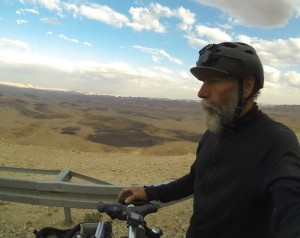
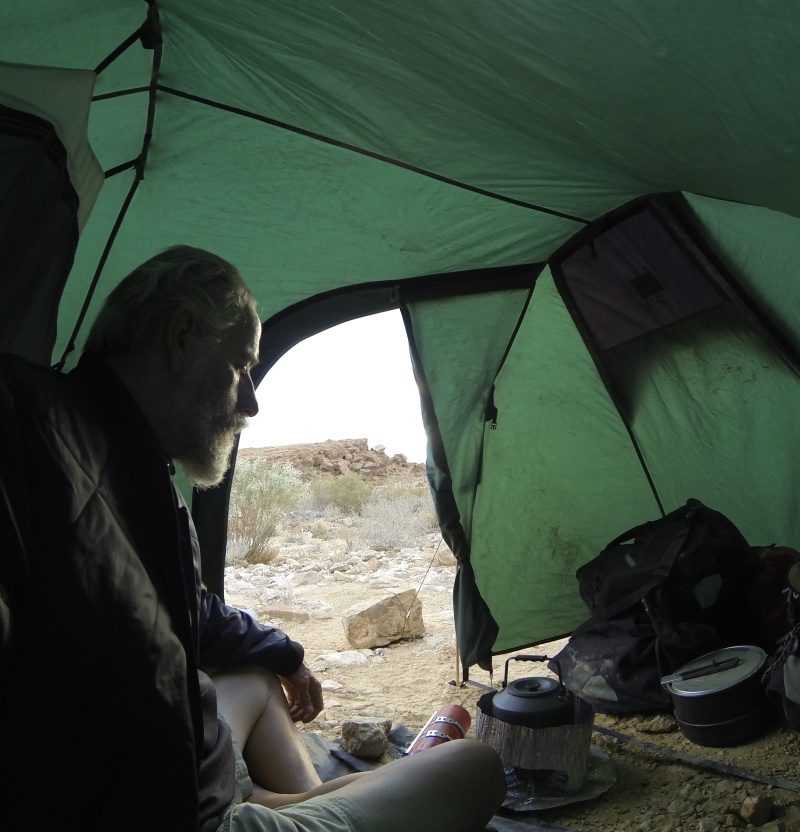
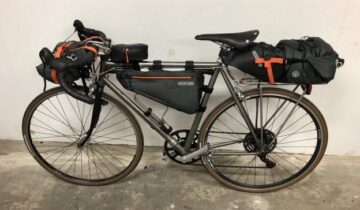
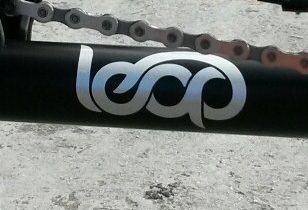
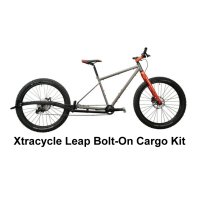
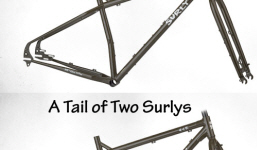
Another good article. And that picture at the end sold me on using my three man tent I’ve been wondering about taking with me the next time out. It will be one of two luxury items I’ll take along. The other is my small Garmen radio. I’ll be able to bathe inside, carefully, as well as spred things out, and, take all my ‘stuff’ indoors with me without it being too cramped. My beloved, 30+ year old one man tent is no longer usable in wet weather. No amount of sealer seems to cure my problem with it. The fabric is simply too old. I have two and three man tents left over from my heavy backpacking days so instead of them sitting in the closets unused, I think I’m going to use them even though they aren’t two pounders like my faithful Sierra Designs one man-er. Thanks for the article.